Case Study: Clinical Reasoning Cycle and Decision Making in Nursing
VerifiedAdded on 2020/06/03
|11
|2822
|329
Case Study
AI Summary
This case study analyzes the clinical reasoning cycle in nursing, focusing on a scenario involving a 10-year-old boy with splenic tuberculosis. The study outlines the eight stages of the cycle: considering the patient's situation, collecting cues, processing information, identifying problems, establishing goals, taking action, evaluating outcomes, and reflecting on the process. The analysis explores how clinical decisions are made, the importance of critical thinking, and the application of relevant nursing standards. The case highlights the effectiveness of the clinical reasoning cycle in improving patient outcomes and emphasizes the importance of reflection and continuous learning in nursing practice. The study also discusses the nursing standards, including comprehensive assessment, developing a plan, and evaluating outcomes to inform nursing practice. The conclusion reiterates the need for critical thinking and reasoning in clinical practice for effective patient care.
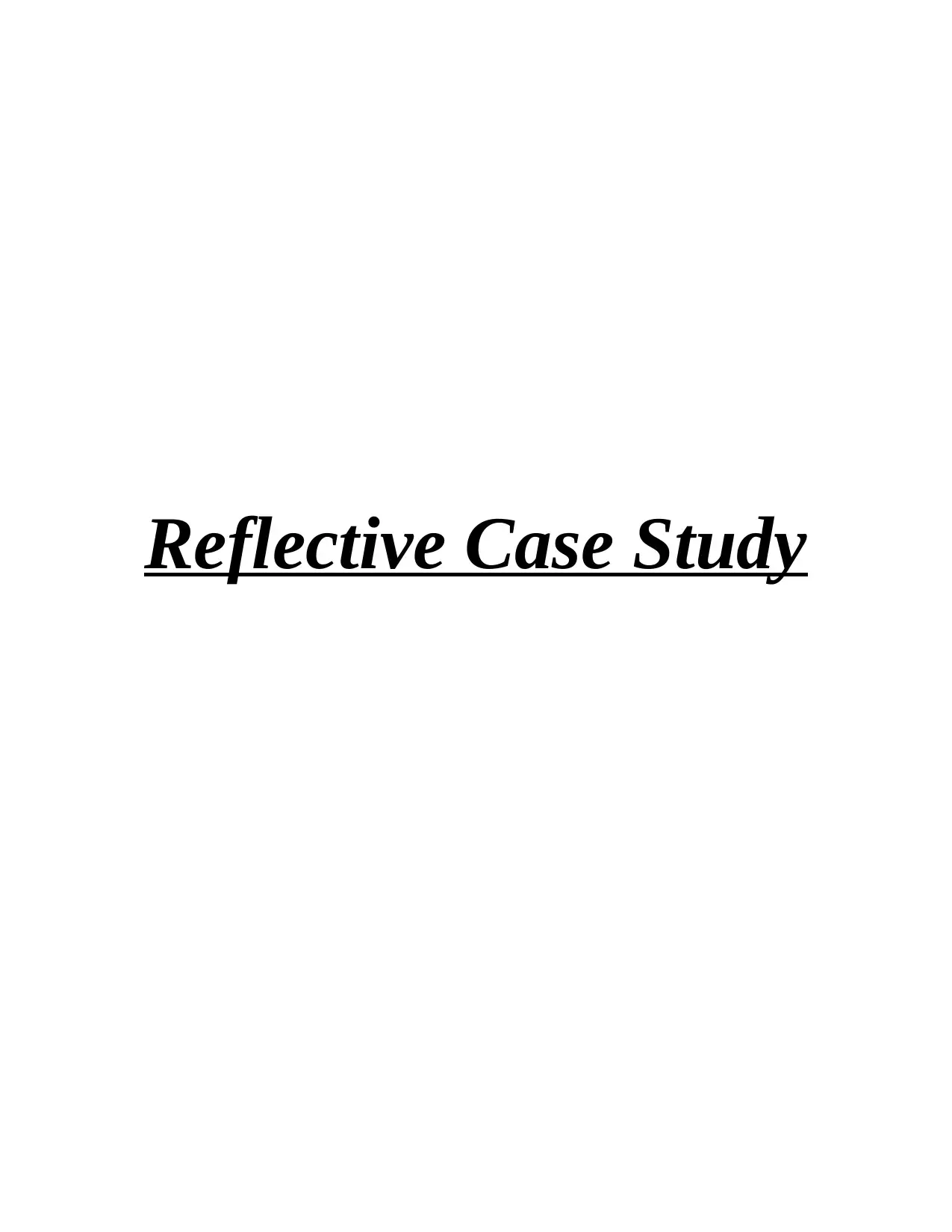
Reflective Case Study
Paraphrase This Document
Need a fresh take? Get an instant paraphrase of this document with our AI Paraphraser
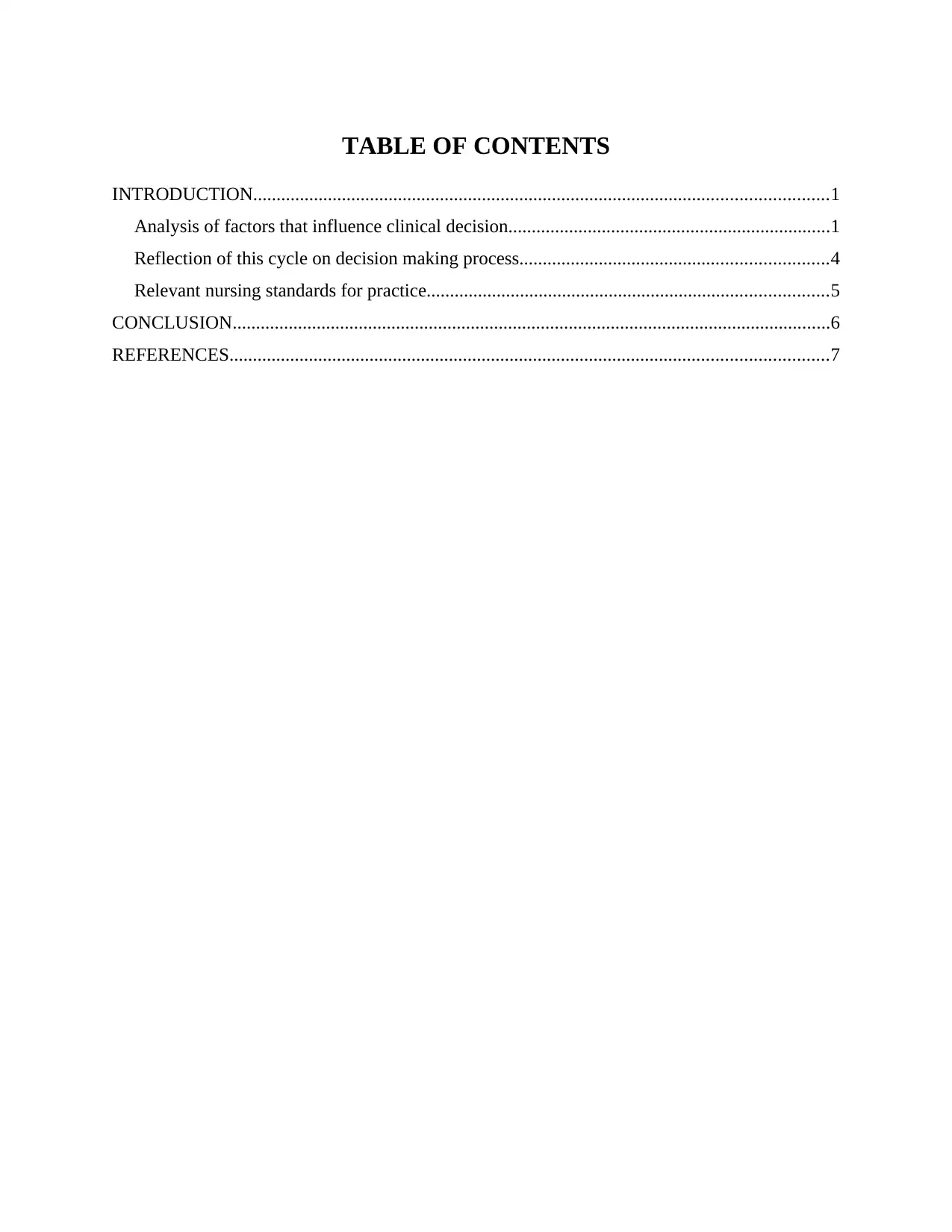
TABLE OF CONTENTS
INTRODUCTION...........................................................................................................................1
Analysis of factors that influence clinical decision.....................................................................1
Reflection of this cycle on decision making process..................................................................4
Relevant nursing standards for practice......................................................................................5
CONCLUSION................................................................................................................................6
REFERENCES................................................................................................................................7
INTRODUCTION...........................................................................................................................1
Analysis of factors that influence clinical decision.....................................................................1
Reflection of this cycle on decision making process..................................................................4
Relevant nursing standards for practice......................................................................................5
CONCLUSION................................................................................................................................6
REFERENCES................................................................................................................................7
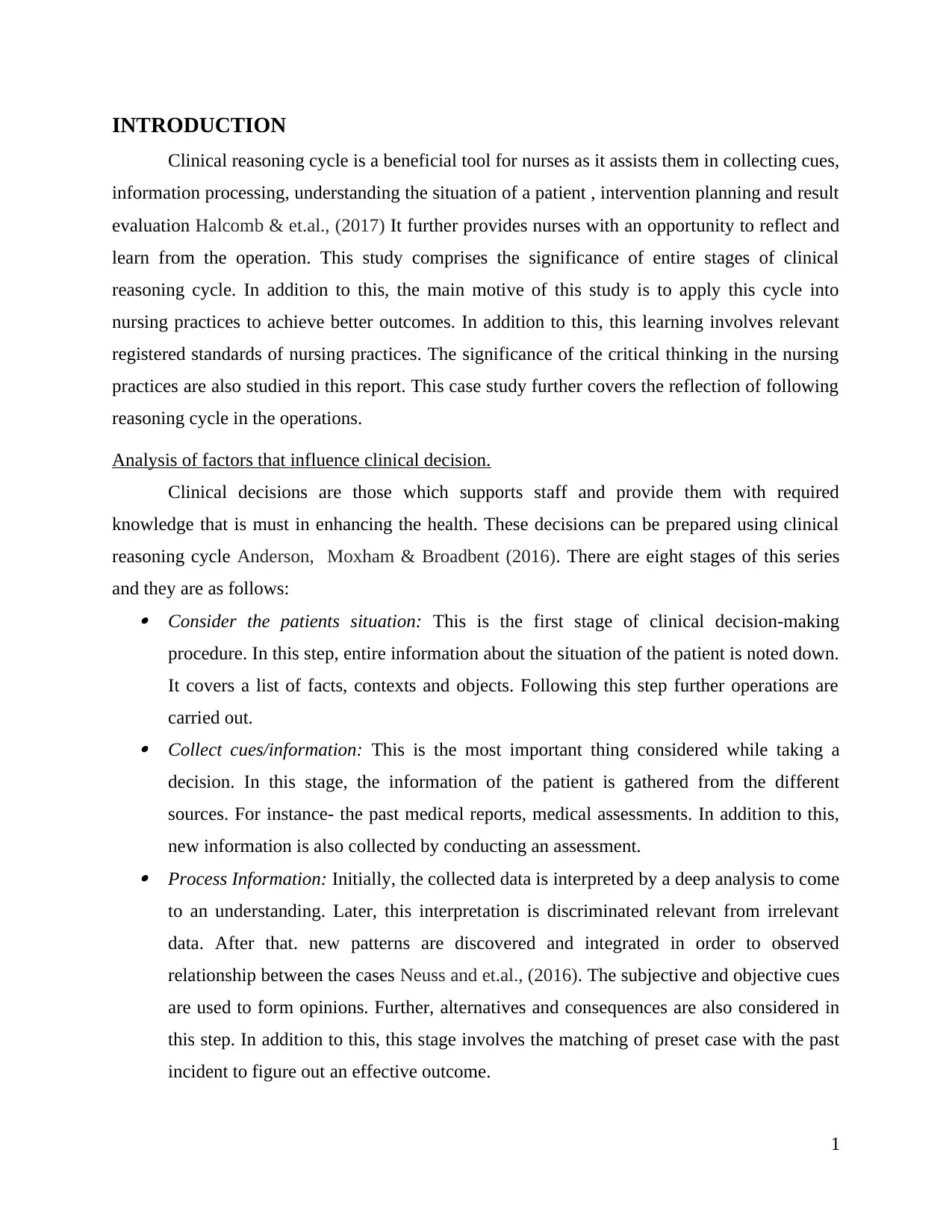
INTRODUCTION
Clinical reasoning cycle is a beneficial tool for nurses as it assists them in collecting cues,
information processing, understanding the situation of a patient , intervention planning and result
evaluation Halcomb & et.al., (2017) It further provides nurses with an opportunity to reflect and
learn from the operation. This study comprises the significance of entire stages of clinical
reasoning cycle. In addition to this, the main motive of this study is to apply this cycle into
nursing practices to achieve better outcomes. In addition to this, this learning involves relevant
registered standards of nursing practices. The significance of the critical thinking in the nursing
practices are also studied in this report. This case study further covers the reflection of following
reasoning cycle in the operations.
Analysis of factors that influence clinical decision.
Clinical decisions are those which supports staff and provide them with required
knowledge that is must in enhancing the health. These decisions can be prepared using clinical
reasoning cycle Anderson, Moxham & Broadbent (2016). There are eight stages of this series
and they are as follows: Consider the patients situation: This is the first stage of clinical decision-making
procedure. In this step, entire information about the situation of the patient is noted down.
It covers a list of facts, contexts and objects. Following this step further operations are
carried out. Collect cues/information: This is the most important thing considered while taking a
decision. In this stage, the information of the patient is gathered from the different
sources. For instance- the past medical reports, medical assessments. In addition to this,
new information is also collected by conducting an assessment. Process Information: Initially, the collected data is interpreted by a deep analysis to come
to an understanding. Later, this interpretation is discriminated relevant from irrelevant
data. After that. new patterns are discovered and integrated in order to observed
relationship between the cases Neuss and et.al., (2016). The subjective and objective cues
are used to form opinions. Further, alternatives and consequences are also considered in
this step. In addition to this, this stage involves the matching of preset case with the past
incident to figure out an effective outcome.
1
Clinical reasoning cycle is a beneficial tool for nurses as it assists them in collecting cues,
information processing, understanding the situation of a patient , intervention planning and result
evaluation Halcomb & et.al., (2017) It further provides nurses with an opportunity to reflect and
learn from the operation. This study comprises the significance of entire stages of clinical
reasoning cycle. In addition to this, the main motive of this study is to apply this cycle into
nursing practices to achieve better outcomes. In addition to this, this learning involves relevant
registered standards of nursing practices. The significance of the critical thinking in the nursing
practices are also studied in this report. This case study further covers the reflection of following
reasoning cycle in the operations.
Analysis of factors that influence clinical decision.
Clinical decisions are those which supports staff and provide them with required
knowledge that is must in enhancing the health. These decisions can be prepared using clinical
reasoning cycle Anderson, Moxham & Broadbent (2016). There are eight stages of this series
and they are as follows: Consider the patients situation: This is the first stage of clinical decision-making
procedure. In this step, entire information about the situation of the patient is noted down.
It covers a list of facts, contexts and objects. Following this step further operations are
carried out. Collect cues/information: This is the most important thing considered while taking a
decision. In this stage, the information of the patient is gathered from the different
sources. For instance- the past medical reports, medical assessments. In addition to this,
new information is also collected by conducting an assessment. Process Information: Initially, the collected data is interpreted by a deep analysis to come
to an understanding. Later, this interpretation is discriminated relevant from irrelevant
data. After that. new patterns are discovered and integrated in order to observed
relationship between the cases Neuss and et.al., (2016). The subjective and objective cues
are used to form opinions. Further, alternatives and consequences are also considered in
this step. In addition to this, this stage involves the matching of preset case with the past
incident to figure out an effective outcome.
1
⊘ This is a preview!⊘
Do you want full access?
Subscribe today to unlock all pages.

Trusted by 1+ million students worldwide
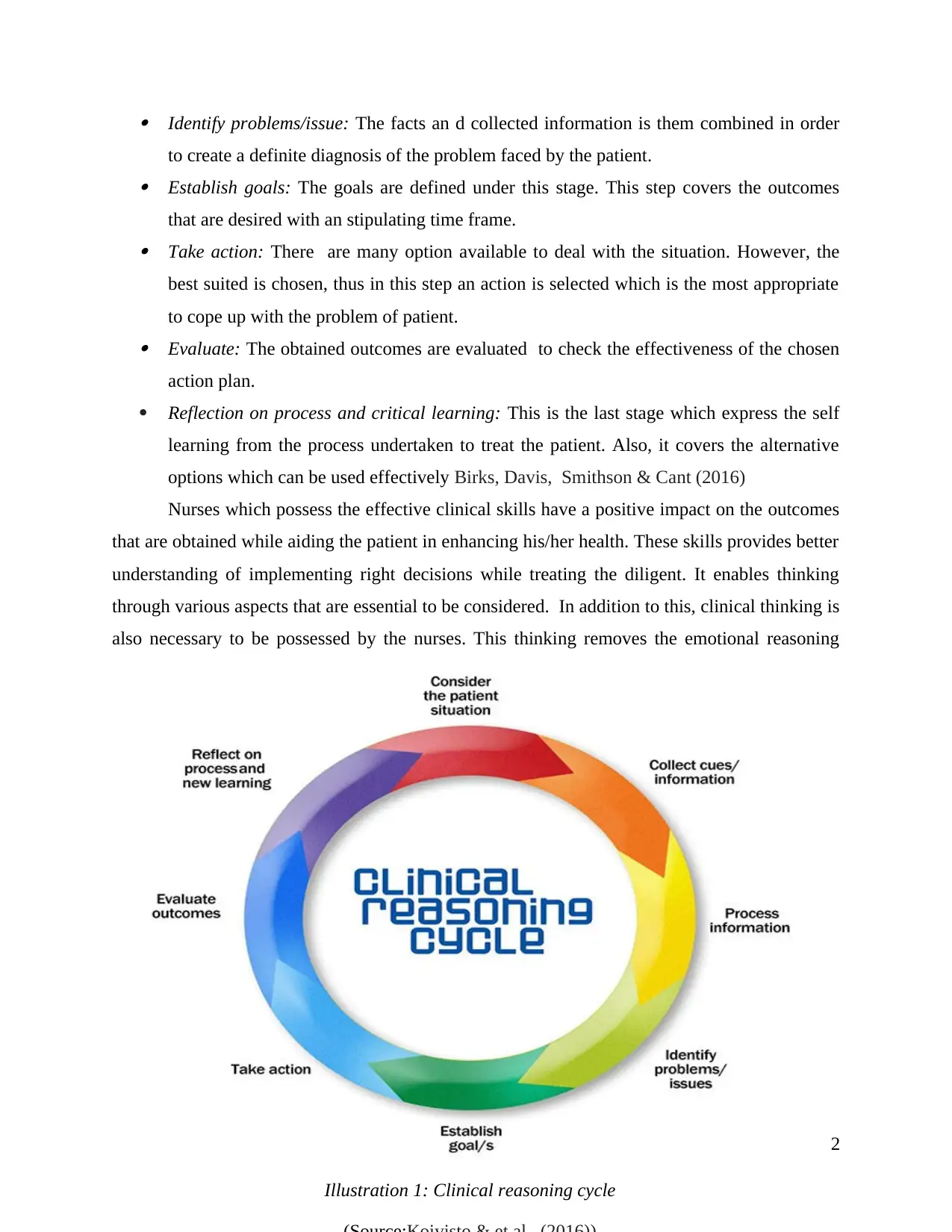
Identify problems/issue: The facts an d collected information is them combined in order
to create a definite diagnosis of the problem faced by the patient. Establish goals: The goals are defined under this stage. This step covers the outcomes
that are desired with an stipulating time frame. Take action: There are many option available to deal with the situation. However, the
best suited is chosen, thus in this step an action is selected which is the most appropriate
to cope up with the problem of patient. Evaluate: The obtained outcomes are evaluated to check the effectiveness of the chosen
action plan.
Reflection on process and critical learning: This is the last stage which express the self
learning from the process undertaken to treat the patient. Also, it covers the alternative
options which can be used effectively Birks, Davis, Smithson & Cant (2016)
Nurses which possess the effective clinical skills have a positive impact on the outcomes
that are obtained while aiding the patient in enhancing his/her health. These skills provides better
understanding of implementing right decisions while treating the diligent. It enables thinking
through various aspects that are essential to be considered. In addition to this, clinical thinking is
also necessary to be possessed by the nurses. This thinking removes the emotional reasoning
2
Illustration 1: Clinical reasoning cycle
to create a definite diagnosis of the problem faced by the patient. Establish goals: The goals are defined under this stage. This step covers the outcomes
that are desired with an stipulating time frame. Take action: There are many option available to deal with the situation. However, the
best suited is chosen, thus in this step an action is selected which is the most appropriate
to cope up with the problem of patient. Evaluate: The obtained outcomes are evaluated to check the effectiveness of the chosen
action plan.
Reflection on process and critical learning: This is the last stage which express the self
learning from the process undertaken to treat the patient. Also, it covers the alternative
options which can be used effectively Birks, Davis, Smithson & Cant (2016)
Nurses which possess the effective clinical skills have a positive impact on the outcomes
that are obtained while aiding the patient in enhancing his/her health. These skills provides better
understanding of implementing right decisions while treating the diligent. It enables thinking
through various aspects that are essential to be considered. In addition to this, clinical thinking is
also necessary to be possessed by the nurses. This thinking removes the emotional reasoning
2
Illustration 1: Clinical reasoning cycle
Paraphrase This Document
Need a fresh take? Get an instant paraphrase of this document with our AI Paraphraser
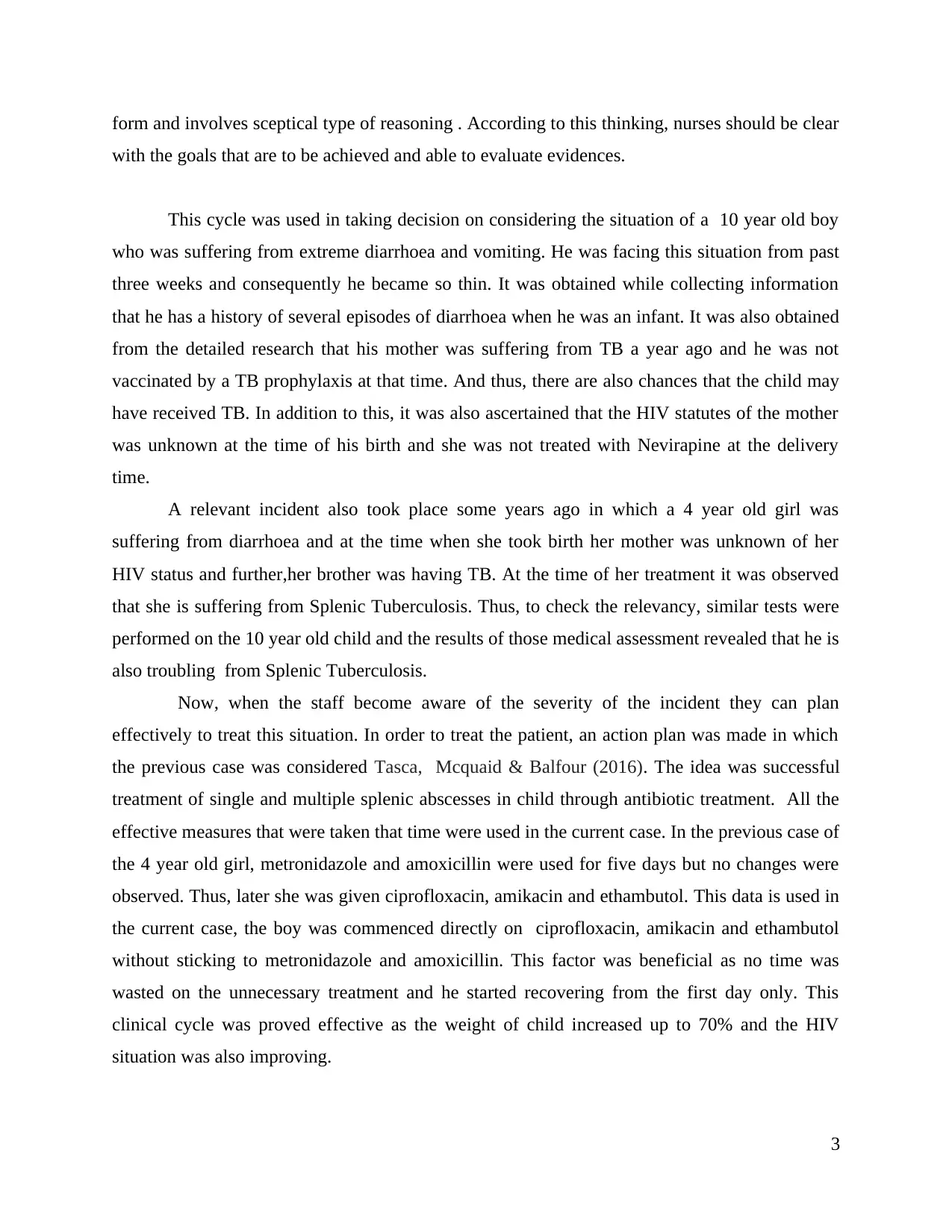
form and involves sceptical type of reasoning . According to this thinking, nurses should be clear
with the goals that are to be achieved and able to evaluate evidences.
This cycle was used in taking decision on considering the situation of a 10 year old boy
who was suffering from extreme diarrhoea and vomiting. He was facing this situation from past
three weeks and consequently he became so thin. It was obtained while collecting information
that he has a history of several episodes of diarrhoea when he was an infant. It was also obtained
from the detailed research that his mother was suffering from TB a year ago and he was not
vaccinated by a TB prophylaxis at that time. And thus, there are also chances that the child may
have received TB. In addition to this, it was also ascertained that the HIV statutes of the mother
was unknown at the time of his birth and she was not treated with Nevirapine at the delivery
time.
A relevant incident also took place some years ago in which a 4 year old girl was
suffering from diarrhoea and at the time when she took birth her mother was unknown of her
HIV status and further,her brother was having TB. At the time of her treatment it was observed
that she is suffering from Splenic Tuberculosis. Thus, to check the relevancy, similar tests were
performed on the 10 year old child and the results of those medical assessment revealed that he is
also troubling from Splenic Tuberculosis.
Now, when the staff become aware of the severity of the incident they can plan
effectively to treat this situation. In order to treat the patient, an action plan was made in which
the previous case was considered Tasca, Mcquaid & Balfour (2016). The idea was successful
treatment of single and multiple splenic abscesses in child through antibiotic treatment. All the
effective measures that were taken that time were used in the current case. In the previous case of
the 4 year old girl, metronidazole and amoxicillin were used for five days but no changes were
observed. Thus, later she was given ciprofloxacin, amikacin and ethambutol. This data is used in
the current case, the boy was commenced directly on ciprofloxacin, amikacin and ethambutol
without sticking to metronidazole and amoxicillin. This factor was beneficial as no time was
wasted on the unnecessary treatment and he started recovering from the first day only. This
clinical cycle was proved effective as the weight of child increased up to 70% and the HIV
situation was also improving.
3
with the goals that are to be achieved and able to evaluate evidences.
This cycle was used in taking decision on considering the situation of a 10 year old boy
who was suffering from extreme diarrhoea and vomiting. He was facing this situation from past
three weeks and consequently he became so thin. It was obtained while collecting information
that he has a history of several episodes of diarrhoea when he was an infant. It was also obtained
from the detailed research that his mother was suffering from TB a year ago and he was not
vaccinated by a TB prophylaxis at that time. And thus, there are also chances that the child may
have received TB. In addition to this, it was also ascertained that the HIV statutes of the mother
was unknown at the time of his birth and she was not treated with Nevirapine at the delivery
time.
A relevant incident also took place some years ago in which a 4 year old girl was
suffering from diarrhoea and at the time when she took birth her mother was unknown of her
HIV status and further,her brother was having TB. At the time of her treatment it was observed
that she is suffering from Splenic Tuberculosis. Thus, to check the relevancy, similar tests were
performed on the 10 year old child and the results of those medical assessment revealed that he is
also troubling from Splenic Tuberculosis.
Now, when the staff become aware of the severity of the incident they can plan
effectively to treat this situation. In order to treat the patient, an action plan was made in which
the previous case was considered Tasca, Mcquaid & Balfour (2016). The idea was successful
treatment of single and multiple splenic abscesses in child through antibiotic treatment. All the
effective measures that were taken that time were used in the current case. In the previous case of
the 4 year old girl, metronidazole and amoxicillin were used for five days but no changes were
observed. Thus, later she was given ciprofloxacin, amikacin and ethambutol. This data is used in
the current case, the boy was commenced directly on ciprofloxacin, amikacin and ethambutol
without sticking to metronidazole and amoxicillin. This factor was beneficial as no time was
wasted on the unnecessary treatment and he started recovering from the first day only. This
clinical cycle was proved effective as the weight of child increased up to 70% and the HIV
situation was also improving.
3
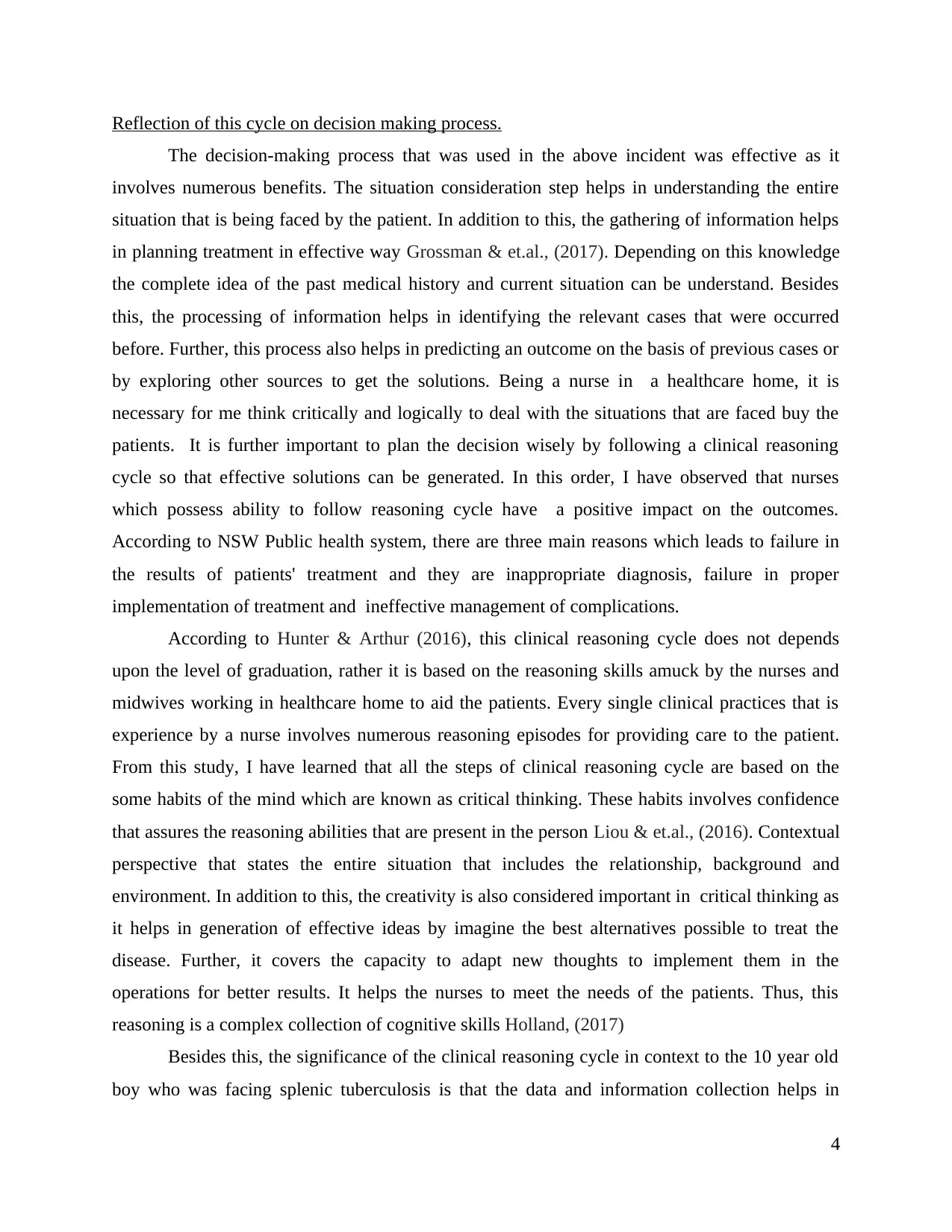
Reflection of this cycle on decision making process.
The decision-making process that was used in the above incident was effective as it
involves numerous benefits. The situation consideration step helps in understanding the entire
situation that is being faced by the patient. In addition to this, the gathering of information helps
in planning treatment in effective way Grossman & et.al., (2017). Depending on this knowledge
the complete idea of the past medical history and current situation can be understand. Besides
this, the processing of information helps in identifying the relevant cases that were occurred
before. Further, this process also helps in predicting an outcome on the basis of previous cases or
by exploring other sources to get the solutions. Being a nurse in a healthcare home, it is
necessary for me think critically and logically to deal with the situations that are faced buy the
patients. It is further important to plan the decision wisely by following a clinical reasoning
cycle so that effective solutions can be generated. In this order, I have observed that nurses
which possess ability to follow reasoning cycle have a positive impact on the outcomes.
According to NSW Public health system, there are three main reasons which leads to failure in
the results of patients' treatment and they are inappropriate diagnosis, failure in proper
implementation of treatment and ineffective management of complications.
According to Hunter & Arthur (2016), this clinical reasoning cycle does not depends
upon the level of graduation, rather it is based on the reasoning skills amuck by the nurses and
midwives working in healthcare home to aid the patients. Every single clinical practices that is
experience by a nurse involves numerous reasoning episodes for providing care to the patient.
From this study, I have learned that all the steps of clinical reasoning cycle are based on the
some habits of the mind which are known as critical thinking. These habits involves confidence
that assures the reasoning abilities that are present in the person Liou & et.al., (2016). Contextual
perspective that states the entire situation that includes the relationship, background and
environment. In addition to this, the creativity is also considered important in critical thinking as
it helps in generation of effective ideas by imagine the best alternatives possible to treat the
disease. Further, it covers the capacity to adapt new thoughts to implement them in the
operations for better results. It helps the nurses to meet the needs of the patients. Thus, this
reasoning is a complex collection of cognitive skills Holland, (2017)
Besides this, the significance of the clinical reasoning cycle in context to the 10 year old
boy who was facing splenic tuberculosis is that the data and information collection helps in
4
The decision-making process that was used in the above incident was effective as it
involves numerous benefits. The situation consideration step helps in understanding the entire
situation that is being faced by the patient. In addition to this, the gathering of information helps
in planning treatment in effective way Grossman & et.al., (2017). Depending on this knowledge
the complete idea of the past medical history and current situation can be understand. Besides
this, the processing of information helps in identifying the relevant cases that were occurred
before. Further, this process also helps in predicting an outcome on the basis of previous cases or
by exploring other sources to get the solutions. Being a nurse in a healthcare home, it is
necessary for me think critically and logically to deal with the situations that are faced buy the
patients. It is further important to plan the decision wisely by following a clinical reasoning
cycle so that effective solutions can be generated. In this order, I have observed that nurses
which possess ability to follow reasoning cycle have a positive impact on the outcomes.
According to NSW Public health system, there are three main reasons which leads to failure in
the results of patients' treatment and they are inappropriate diagnosis, failure in proper
implementation of treatment and ineffective management of complications.
According to Hunter & Arthur (2016), this clinical reasoning cycle does not depends
upon the level of graduation, rather it is based on the reasoning skills amuck by the nurses and
midwives working in healthcare home to aid the patients. Every single clinical practices that is
experience by a nurse involves numerous reasoning episodes for providing care to the patient.
From this study, I have learned that all the steps of clinical reasoning cycle are based on the
some habits of the mind which are known as critical thinking. These habits involves confidence
that assures the reasoning abilities that are present in the person Liou & et.al., (2016). Contextual
perspective that states the entire situation that includes the relationship, background and
environment. In addition to this, the creativity is also considered important in critical thinking as
it helps in generation of effective ideas by imagine the best alternatives possible to treat the
disease. Further, it covers the capacity to adapt new thoughts to implement them in the
operations for better results. It helps the nurses to meet the needs of the patients. Thus, this
reasoning is a complex collection of cognitive skills Holland, (2017)
Besides this, the significance of the clinical reasoning cycle in context to the 10 year old
boy who was facing splenic tuberculosis is that the data and information collection helps in
4
⊘ This is a preview!⊘
Do you want full access?
Subscribe today to unlock all pages.

Trusted by 1+ million students worldwide
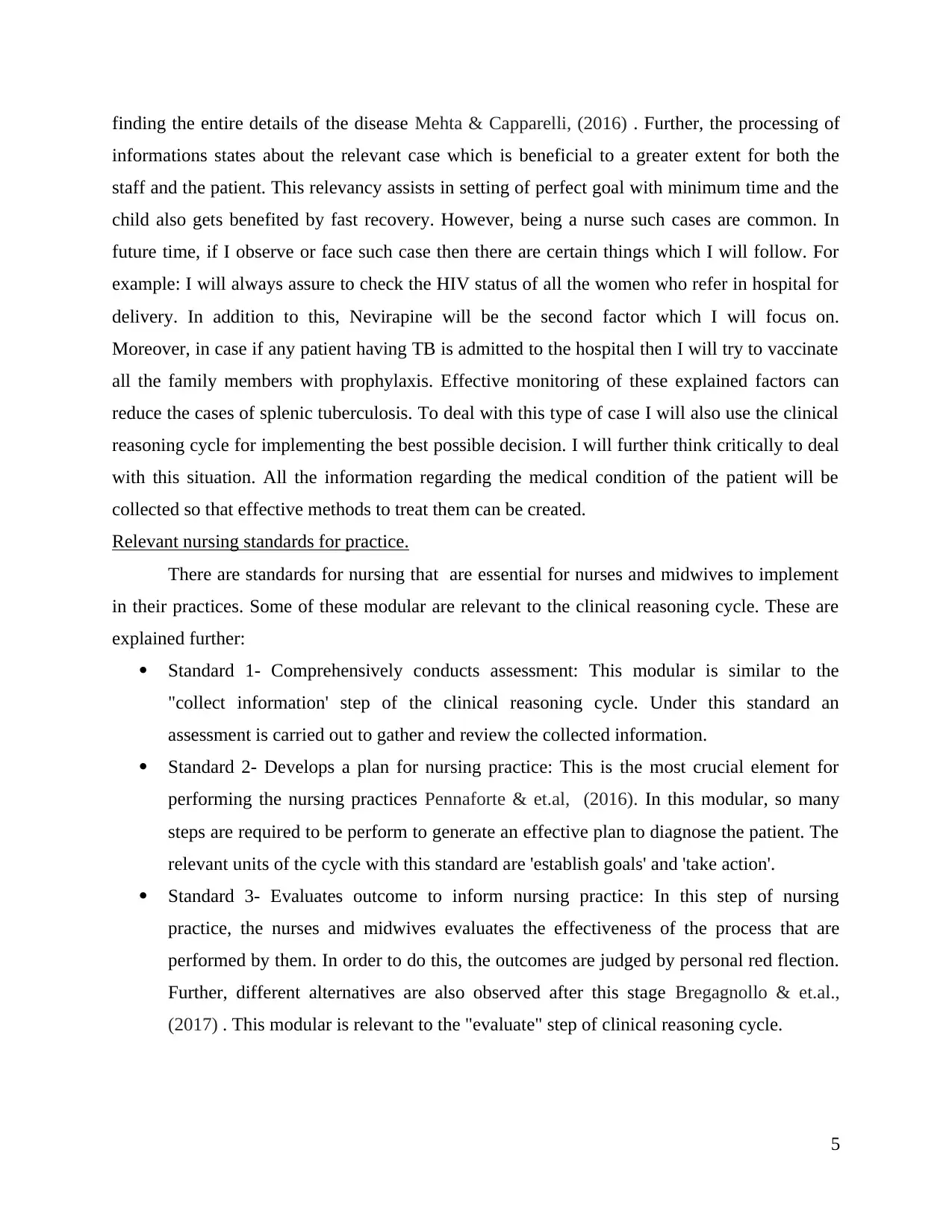
finding the entire details of the disease Mehta & Capparelli, (2016) . Further, the processing of
informations states about the relevant case which is beneficial to a greater extent for both the
staff and the patient. This relevancy assists in setting of perfect goal with minimum time and the
child also gets benefited by fast recovery. However, being a nurse such cases are common. In
future time, if I observe or face such case then there are certain things which I will follow. For
example: I will always assure to check the HIV status of all the women who refer in hospital for
delivery. In addition to this, Nevirapine will be the second factor which I will focus on.
Moreover, in case if any patient having TB is admitted to the hospital then I will try to vaccinate
all the family members with prophylaxis. Effective monitoring of these explained factors can
reduce the cases of splenic tuberculosis. To deal with this type of case I will also use the clinical
reasoning cycle for implementing the best possible decision. I will further think critically to deal
with this situation. All the information regarding the medical condition of the patient will be
collected so that effective methods to treat them can be created.
Relevant nursing standards for practice.
There are standards for nursing that are essential for nurses and midwives to implement
in their practices. Some of these modular are relevant to the clinical reasoning cycle. These are
explained further:
Standard 1- Comprehensively conducts assessment: This modular is similar to the
"collect information' step of the clinical reasoning cycle. Under this standard an
assessment is carried out to gather and review the collected information.
Standard 2- Develops a plan for nursing practice: This is the most crucial element for
performing the nursing practices Pennaforte & et.al, (2016). In this modular, so many
steps are required to be perform to generate an effective plan to diagnose the patient. The
relevant units of the cycle with this standard are 'establish goals' and 'take action'.
Standard 3- Evaluates outcome to inform nursing practice: In this step of nursing
practice, the nurses and midwives evaluates the effectiveness of the process that are
performed by them. In order to do this, the outcomes are judged by personal red flection.
Further, different alternatives are also observed after this stage Bregagnollo & et.al.,
(2017) . This modular is relevant to the "evaluate" step of clinical reasoning cycle.
5
informations states about the relevant case which is beneficial to a greater extent for both the
staff and the patient. This relevancy assists in setting of perfect goal with minimum time and the
child also gets benefited by fast recovery. However, being a nurse such cases are common. In
future time, if I observe or face such case then there are certain things which I will follow. For
example: I will always assure to check the HIV status of all the women who refer in hospital for
delivery. In addition to this, Nevirapine will be the second factor which I will focus on.
Moreover, in case if any patient having TB is admitted to the hospital then I will try to vaccinate
all the family members with prophylaxis. Effective monitoring of these explained factors can
reduce the cases of splenic tuberculosis. To deal with this type of case I will also use the clinical
reasoning cycle for implementing the best possible decision. I will further think critically to deal
with this situation. All the information regarding the medical condition of the patient will be
collected so that effective methods to treat them can be created.
Relevant nursing standards for practice.
There are standards for nursing that are essential for nurses and midwives to implement
in their practices. Some of these modular are relevant to the clinical reasoning cycle. These are
explained further:
Standard 1- Comprehensively conducts assessment: This modular is similar to the
"collect information' step of the clinical reasoning cycle. Under this standard an
assessment is carried out to gather and review the collected information.
Standard 2- Develops a plan for nursing practice: This is the most crucial element for
performing the nursing practices Pennaforte & et.al, (2016). In this modular, so many
steps are required to be perform to generate an effective plan to diagnose the patient. The
relevant units of the cycle with this standard are 'establish goals' and 'take action'.
Standard 3- Evaluates outcome to inform nursing practice: In this step of nursing
practice, the nurses and midwives evaluates the effectiveness of the process that are
performed by them. In order to do this, the outcomes are judged by personal red flection.
Further, different alternatives are also observed after this stage Bregagnollo & et.al.,
(2017) . This modular is relevant to the "evaluate" step of clinical reasoning cycle.
5
Paraphrase This Document
Need a fresh take? Get an instant paraphrase of this document with our AI Paraphraser
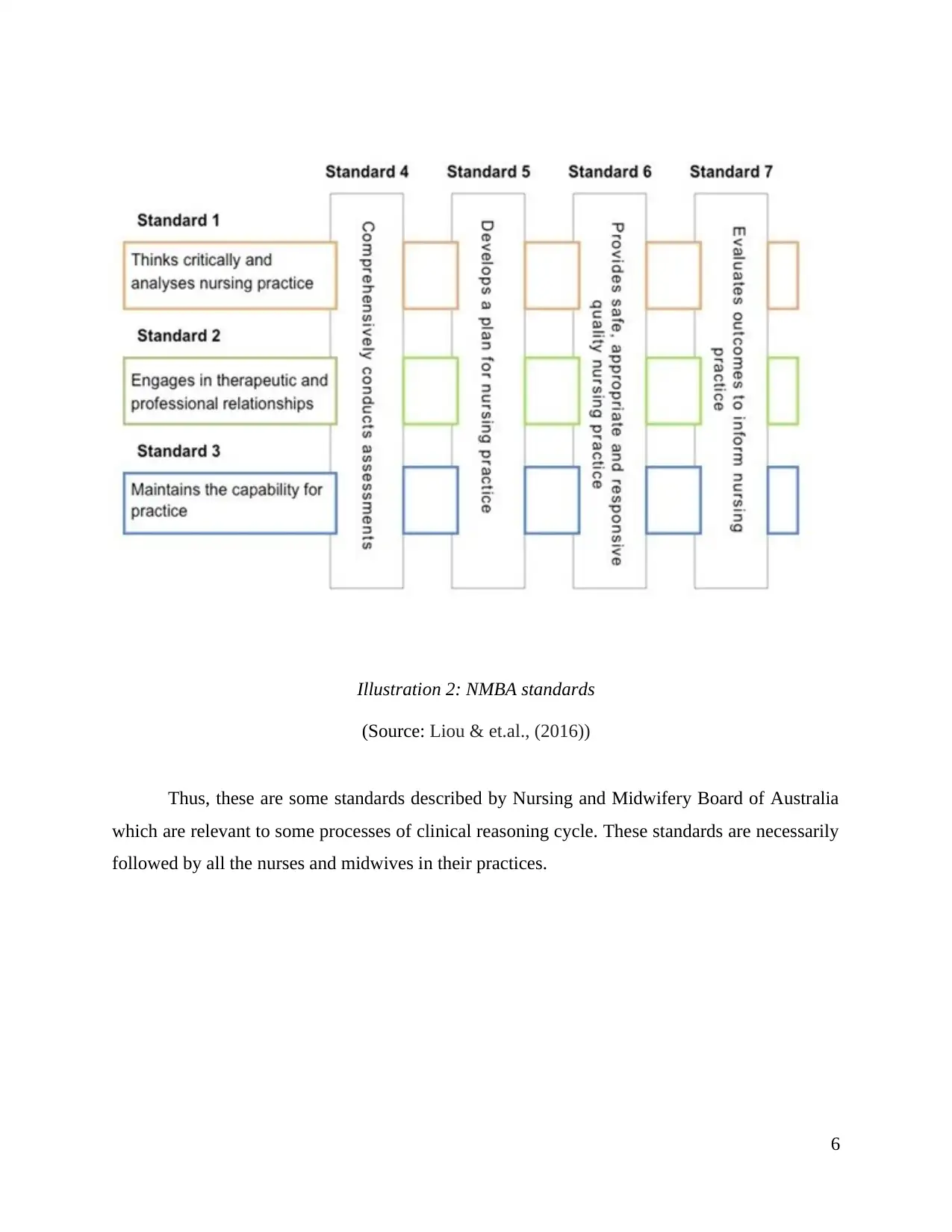
Thus, these are some standards described by Nursing and Midwifery Board of Australia
which are relevant to some processes of clinical reasoning cycle. These standards are necessarily
followed by all the nurses and midwives in their practices.
6
Illustration 2: NMBA standards
(Source: Liou & et.al., (2016))
which are relevant to some processes of clinical reasoning cycle. These standards are necessarily
followed by all the nurses and midwives in their practices.
6
Illustration 2: NMBA standards
(Source: Liou & et.al., (2016))
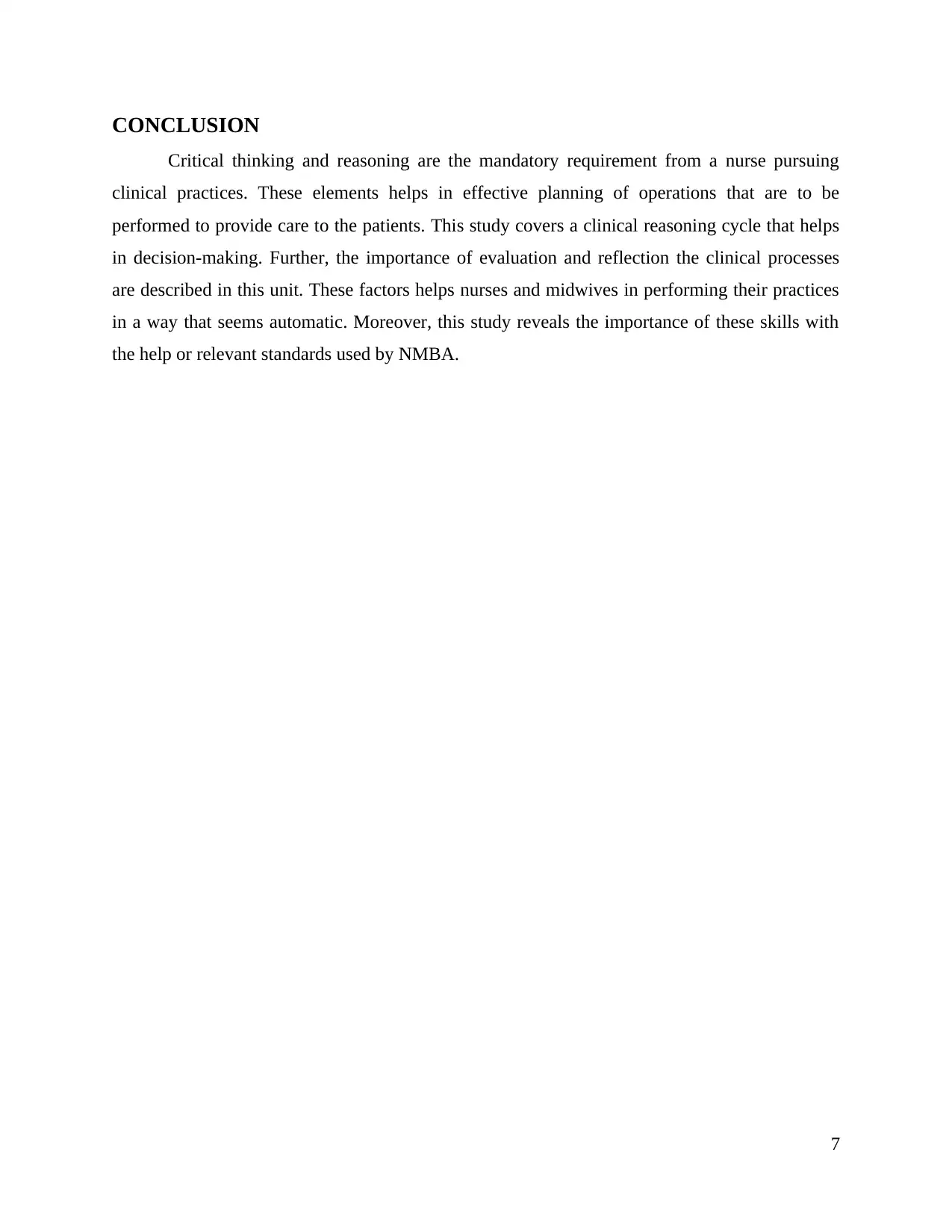
CONCLUSION
Critical thinking and reasoning are the mandatory requirement from a nurse pursuing
clinical practices. These elements helps in effective planning of operations that are to be
performed to provide care to the patients. This study covers a clinical reasoning cycle that helps
in decision-making. Further, the importance of evaluation and reflection the clinical processes
are described in this unit. These factors helps nurses and midwives in performing their practices
in a way that seems automatic. Moreover, this study reveals the importance of these skills with
the help or relevant standards used by NMBA.
7
Critical thinking and reasoning are the mandatory requirement from a nurse pursuing
clinical practices. These elements helps in effective planning of operations that are to be
performed to provide care to the patients. This study covers a clinical reasoning cycle that helps
in decision-making. Further, the importance of evaluation and reflection the clinical processes
are described in this unit. These factors helps nurses and midwives in performing their practices
in a way that seems automatic. Moreover, this study reveals the importance of these skills with
the help or relevant standards used by NMBA.
7
⊘ This is a preview!⊘
Do you want full access?
Subscribe today to unlock all pages.

Trusted by 1+ million students worldwide
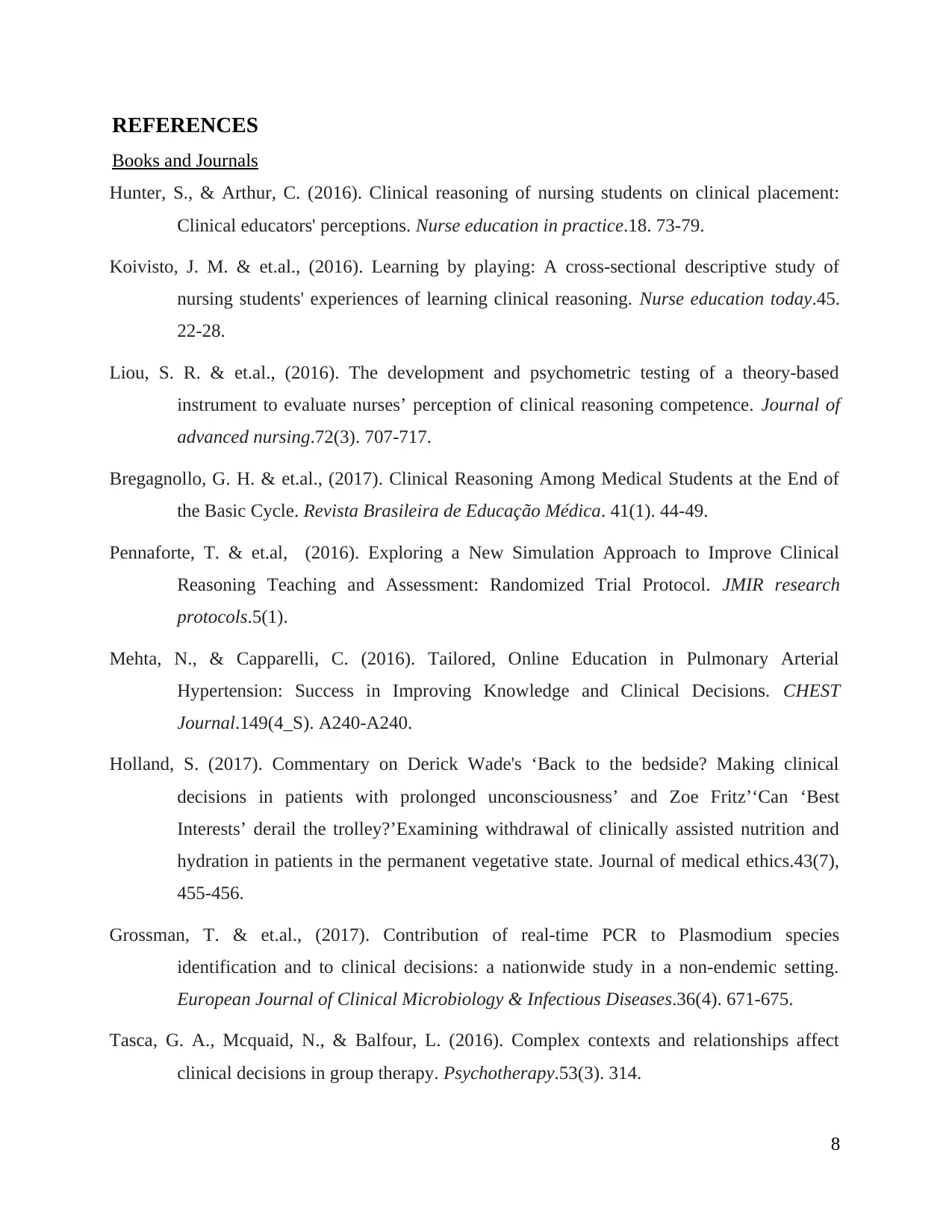
REFERENCES
Books and Journals
Hunter, S., & Arthur, C. (2016). Clinical reasoning of nursing students on clinical placement:
Clinical educators' perceptions. Nurse education in practice.18. 73-79.
Koivisto, J. M. & et.al., (2016). Learning by playing: A cross-sectional descriptive study of
nursing students' experiences of learning clinical reasoning. Nurse education today.45.
22-28.
Liou, S. R. & et.al., (2016). The development and psychometric testing of a theory‐based
instrument to evaluate nurses’ perception of clinical reasoning competence. Journal of
advanced nursing.72(3). 707-717.
Bregagnollo, G. H. & et.al., (2017). Clinical Reasoning Among Medical Students at the End of
the Basic Cycle. Revista Brasileira de Educação Médica. 41(1). 44-49.
Pennaforte, T. & et.al, (2016). Exploring a New Simulation Approach to Improve Clinical
Reasoning Teaching and Assessment: Randomized Trial Protocol. JMIR research
protocols.5(1).
Mehta, N., & Capparelli, C. (2016). Tailored, Online Education in Pulmonary Arterial
Hypertension: Success in Improving Knowledge and Clinical Decisions. CHEST
Journal.149(4_S). A240-A240.
Holland, S. (2017). Commentary on Derick Wade's ‘Back to the bedside? Making clinical
decisions in patients with prolonged unconsciousness’ and Zoe Fritz’‘Can ‘Best
Interests’ derail the trolley?’Examining withdrawal of clinically assisted nutrition and
hydration in patients in the permanent vegetative state. Journal of medical ethics.43(7),
455-456.
Grossman, T. & et.al., (2017). Contribution of real-time PCR to Plasmodium species
identification and to clinical decisions: a nationwide study in a non-endemic setting.
European Journal of Clinical Microbiology & Infectious Diseases.36(4). 671-675.
Tasca, G. A., Mcquaid, N., & Balfour, L. (2016). Complex contexts and relationships affect
clinical decisions in group therapy. Psychotherapy.53(3). 314.
8
Books and Journals
Hunter, S., & Arthur, C. (2016). Clinical reasoning of nursing students on clinical placement:
Clinical educators' perceptions. Nurse education in practice.18. 73-79.
Koivisto, J. M. & et.al., (2016). Learning by playing: A cross-sectional descriptive study of
nursing students' experiences of learning clinical reasoning. Nurse education today.45.
22-28.
Liou, S. R. & et.al., (2016). The development and psychometric testing of a theory‐based
instrument to evaluate nurses’ perception of clinical reasoning competence. Journal of
advanced nursing.72(3). 707-717.
Bregagnollo, G. H. & et.al., (2017). Clinical Reasoning Among Medical Students at the End of
the Basic Cycle. Revista Brasileira de Educação Médica. 41(1). 44-49.
Pennaforte, T. & et.al, (2016). Exploring a New Simulation Approach to Improve Clinical
Reasoning Teaching and Assessment: Randomized Trial Protocol. JMIR research
protocols.5(1).
Mehta, N., & Capparelli, C. (2016). Tailored, Online Education in Pulmonary Arterial
Hypertension: Success in Improving Knowledge and Clinical Decisions. CHEST
Journal.149(4_S). A240-A240.
Holland, S. (2017). Commentary on Derick Wade's ‘Back to the bedside? Making clinical
decisions in patients with prolonged unconsciousness’ and Zoe Fritz’‘Can ‘Best
Interests’ derail the trolley?’Examining withdrawal of clinically assisted nutrition and
hydration in patients in the permanent vegetative state. Journal of medical ethics.43(7),
455-456.
Grossman, T. & et.al., (2017). Contribution of real-time PCR to Plasmodium species
identification and to clinical decisions: a nationwide study in a non-endemic setting.
European Journal of Clinical Microbiology & Infectious Diseases.36(4). 671-675.
Tasca, G. A., Mcquaid, N., & Balfour, L. (2016). Complex contexts and relationships affect
clinical decisions in group therapy. Psychotherapy.53(3). 314.
8
Paraphrase This Document
Need a fresh take? Get an instant paraphrase of this document with our AI Paraphraser
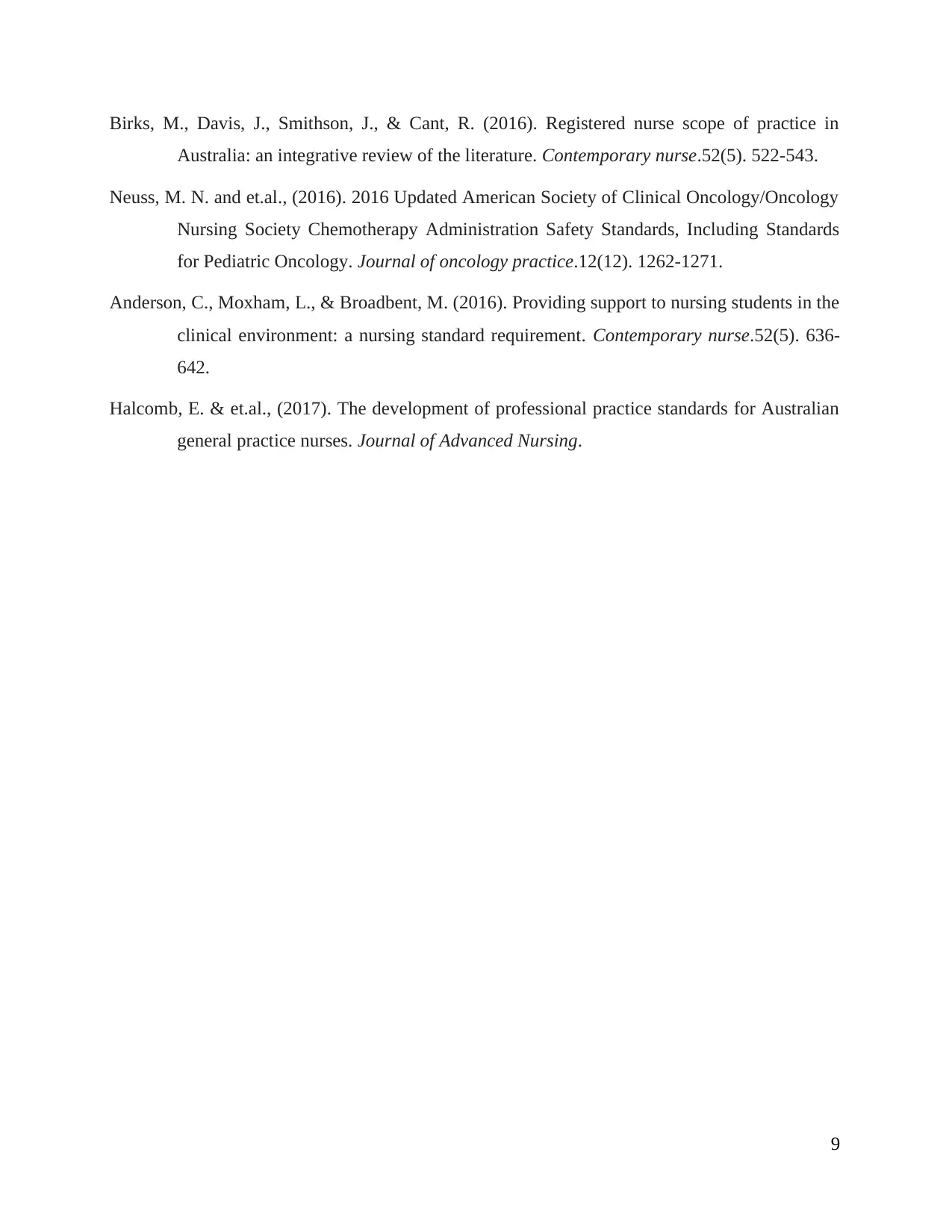
Birks, M., Davis, J., Smithson, J., & Cant, R. (2016). Registered nurse scope of practice in
Australia: an integrative review of the literature. Contemporary nurse.52(5). 522-543.
Neuss, M. N. and et.al., (2016). 2016 Updated American Society of Clinical Oncology/Oncology
Nursing Society Chemotherapy Administration Safety Standards, Including Standards
for Pediatric Oncology. Journal of oncology practice.12(12). 1262-1271.
Anderson, C., Moxham, L., & Broadbent, M. (2016). Providing support to nursing students in the
clinical environment: a nursing standard requirement. Contemporary nurse.52(5). 636-
642.
Halcomb, E. & et.al., (2017). The development of professional practice standards for Australian
general practice nurses. Journal of Advanced Nursing.
9
Australia: an integrative review of the literature. Contemporary nurse.52(5). 522-543.
Neuss, M. N. and et.al., (2016). 2016 Updated American Society of Clinical Oncology/Oncology
Nursing Society Chemotherapy Administration Safety Standards, Including Standards
for Pediatric Oncology. Journal of oncology practice.12(12). 1262-1271.
Anderson, C., Moxham, L., & Broadbent, M. (2016). Providing support to nursing students in the
clinical environment: a nursing standard requirement. Contemporary nurse.52(5). 636-
642.
Halcomb, E. & et.al., (2017). The development of professional practice standards for Australian
general practice nurses. Journal of Advanced Nursing.
9
1 out of 11
Related Documents
Your All-in-One AI-Powered Toolkit for Academic Success.
+13062052269
info@desklib.com
Available 24*7 on WhatsApp / Email
![[object Object]](/_next/static/media/star-bottom.7253800d.svg)
Unlock your academic potential
Copyright © 2020–2025 A2Z Services. All Rights Reserved. Developed and managed by ZUCOL.





